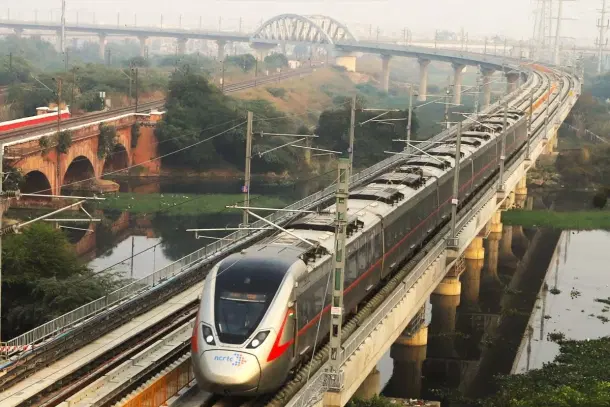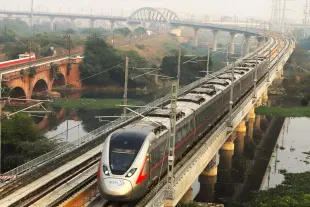Infrastructure
Delhi-Ghaziabad RRTS — A Year Ender: Namo Bharat Train On Tracks With Construction Work Gaining Pace
Arun Kumar Das
Dec 26, 2023, 12:29 PM | Updated 12:36 PM IST
Save & read from anywhere!
Bookmark stories for easy access on any device or the Swarajya app.


With the opening of a section of the Regional Rapid Transit System (RRTS) corridor and the ongoing construction work gaining pace, the year 2023 was a year of achievements for the National Capital Region Transport Corporation (NCRTC).
This year, NCRTC achieved a significant milestone in its journey to provide the country with an advanced and transformative transit service through the Delhi-Ghaziabad-Meerut RRTS corridor.
On 20 October 2023, Prime Minister Narendra Modi inaugurated India's first RRTS and flagged off the Namo Bharat train. With this, the 17-km-long priority section between Sahibabad and Duhai Depot was operationalised for the public.
The construction of the RRTS corridor began in 2019, and commencing the operations of the priority section within just four years is a significant accomplishment. It is especially remarkable considering that it is an entirely new system with all the sub-systems and trains of the RRTS corridor having been developed in an entirely new manner.
Along with this, with the relentless efforts of the NCRTC team, the construction of the corridor continued to expand in the direction of Delhi and Meerut, progressing consistently.
As the countdown to the end of this year has begun, NCRTC has reached a stage in the journey where trial runs have commenced in the sections beyond the priority section, as well.
Operations On Priority Section:
This journey, for NCRTC, began with the commencement of trial runs on the priority section. The trial runs began in the first week of January 2023.
During these trial runs, various sub-systems of the RRTS, such as the rolling stock, ETCS-2 signalling on the LTE network, ballastless track, and overhead equipment, were tested independently and later in synergy with each other, to ensure their safe and compliant implementation and compatibility.
Stepping ahead in this direction, in June 2023, the Commissioner of Metro Rail Safety (CMRS) approved the operation of Namo Bharat train services on the priority section between Sahibabad and Duhai Depot.
With the approval from CMRS, this section of the RRTS became the first railway network in the country to be opened for operation on the entire section with a maximum operational speed of 160 kilometres per hour.
On 20 October 2023, in the presence of the Chief Minister of Uttar Pradesh Yogi Adityanath, the Governor of Uttar Pradesh Anandiben Patel, and the Union Minister of Petroleum and Natural Gas, Housing and Urban Affairs, Hardeep Singh Puri, the Prime Minister inaugurated India's first RRTS and flagged off the Namo Bharat Train.
With this, from 21 October 2023, this section became operational for the public.
In the journey of providing rapid regional connectivity in the national capital region, another crucial milestone was achieved when the tunnelling work for the entire Delhi-Ghaziabad-Meerut RRTS corridor was completed successfully.
This corridor has a total of four underground stations: Anand Vihar in Delhi, and Meerut Central, Bhainsali, and Begumpul in Meerut.
The tunnelling journey of NCRTC commenced in February 2022, when Sudarshan 4.1 (tunnel boring machine) was lowered into the launching shaft built at Anand Vihar, New Delhi to bore the tunnel between Anand Vihar towards New Ashok Nagar.
On 29 August 2023, with the completion of boring the 2-km-long tunnel between Anand Vihar and Sahibabad, the entire tunnelling work for the RRTS corridor was completed.
It is a remarkable feat to construct parallel tunnels in the entire 12-km-long underground section in less than 18 months, achieved by using seven state-of-the-art Sudarshan-TBM.
In order to construct these tunnels, more than 80,000 pre-cast segments have been used. These high-precision pre-cast tunnel segments were cast at the state-of-the-art casting yards established at Karkardooma, New Delhi, and Shatabdi Nagar, Meerut.
The diameter of the RRTS tunnels is 6.5 m, which is highly optimised as compared to global benchmarks of tunnels for a similar design speed of 180 kmph, with wider and higher rolling stock.
Solar Power Plants At Depots And Stations
In step with its commitment to adopt renewable energy and sustainable practices, NCRTC established a state-of-the-art solar power plant at RRTS Depot at Duhai and Sahibabad RRTS Station and Duhai Depot RRTS Station.
With a total capacity of 729 kW, the solar power plant established at Sahibabad station is equipped with 1,620 high-efficiency solar panels.
The plant will generate about 10 lakh units of electricity per annum, as against the annual consumption of about 7.3 lakh per annum for the auxiliary load of the station, thus making the Sahibabad Station a ‘green station' with the distinction of being 'carbon negative’.
The solar plant at the Duhai Depot Station is equipped with 320 solar panels with an installed capacity of 108 kW.
Earlier in July, a solar power plant was established at RRTS Depot in Duhai with an installed capacity of 585 kW, making this depot a green depot.
This initiative represents a major stride towards sustainability, as together, these solar power plants are expected to reduce approximately 1,600 tonnes of carbon-di-oxide emissions per year.
The reduction is achieved by substituting conventional fossil fuel-based power sources with clean and green solar energy. This transition to solar energy aligns with NCRTC's commitment to reducing its carbon footprint while optimising operational costs.
The solar energy produced through this solar plant will be monitored and optimised by a cutting-edge cloud-based application which will track the output regularly. This advanced technology ensures transparency, efficiency, and seamless management of the solar energy infrastructure.
This year, NCRTC organised various skill development training programs in the villages of Ghaziabad and Meerut districts. In this series, farmers were trained in modern agricultural techniques, and women were provided self-defence training.
In addition, NCRTC is making efforts not only to ensure the safe travel of women but also to empower them. In this direction, NCRTC organised a self-defence training programme for students, at D N Degree College, in Meerut.
The programme provided training by specialised instructors from the Central Industrial Security Force, and more than 200 female students from various colleges in Meerut took part in the training.
Namo Bharat Train Travels Upto Modi Nagar South
After the commencement of operation of the priority section on the Delhi-Meerut-Ghaziabad RRTS corridor, the trial run has now begun in the section ahead of it.
Trials run of the Namo Bharat trains are being conducted from Duhai to Modi Nagar South Station. In this process, the electric OHE has been charged with a capacity of 25 kilo-volts from Murad Nagar receiving sub-station to Modi Nagar South and following this, the trial runs of the Namo Bharat train are being carried out in this section.
Currently, the trains are running from Duhai Station to Murad Nagar Station and then further to Modi Nagar South, covering a distance of approximately 12 kilometres.
The 25 km stretch between Duhai and Meerut South RRTS station is the next section of the RRTS corridor to be operationalised for the public after the priority section. This section has a total of four stations, namely Murad Nagar, Modi Nagar North, Modi Nagar South, and Meerut South.
In June, the construction of the viaduct up to Meerut South was completed with the installation of the last span. Since then, various construction works like track laying, OHE installation, signalling and telecom, and electrical have been progressing at pace in this section.
At present, track laying work is almost complete, and other works are in their final stages. Additionally, Muradnagar RSS is ready to supply electricity from Murad Nagar to Meerut South.
Soon, OHE will be charged between Modi Nagar North and Meerut South stations, and trial runs will be conducted in this section by running trains up to Meerut South station.
The construction of the RRTS corridor gained momentum in Delhi and Meerut. With the construction work progressing at pace, the outline of the RRTS viaduct from Delhi to Meerut became visible and most of the stations took shape.
In the elevated section of the Delhi segment, approximately 7 kilometres of the nearly 9-kilometre-long viaduct has been completed. As part of this, the construction of a bridge over the Yamuna River has been successfully completed, which was a complex process.
Additionally, in the congested area of Kondli, a total of 360 metres of special steel spans were installed to cross the Gazipur Drain. Furthermore, the RRTS viaduct in New Ashok Nagar crossed over the Delhi Metro's Blue Line. Currently, construction work is progressing to cross the Barapula viaduct.
Along with this, the track laying activities have been completed in about 1.5 track kilometres and the installation of OHE masts over about 2 kilometres have been completed on the constructed viaduct. The construction of two stations in the elevated section, Sarai Kale Khan and New Ashok Nagar RRTS stations is also progressing.
The majority of civil construction work at Sarai Kale Khan RRTS station has been completed, and currently, finishing, electrical, and maintenance work is underway.
Similarly, civil construction work is being carried out for the concourse and platform level at the New Ashok Nagar station.
The tunnelling work in the underground section of Delhi is complete, and, the concourse and platform levels at the Anand Vihar station have been constructed and are now undergoing flooring work.
Similarly, construction work in Meerut is progressing rapidly. The RRTS corridor has successfully crossed over the Delhi-Meerut Expressway. Additionally, to cross the railway line at Partapur, a 90-metre-long special steel span, including eight large girders, has been installed.
Furthermore, the construction of Meerut Metro stations, including Partapur, Rithani, Shatabdi Nagar, Bramhapuri, Meerut Central, and Bhaisali, is in its advanced stages. The construction of the Begumpul RRTS station is also being expedited.
In addition to these achievements, NCRTC has organised various community awareness programs to educate the public about the RRTS project. As part of this initiative, art competitions have been conducted in schools, and knowledge-sharing sessions have been organised in colleges.
The purpose of this event is to encourage people to use public transportation instead of private vehicles, reducing dependence on private vehicles and promoting sustainable urban mobility.
NCRTC aims to operationalise the entire Delhi-Ghaziabad-Meerut RRTS corridor by June 2025, and witnessing the pace at which construction work is progressing, this destination is now within reach.





